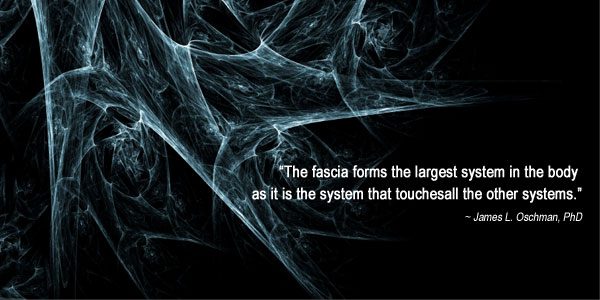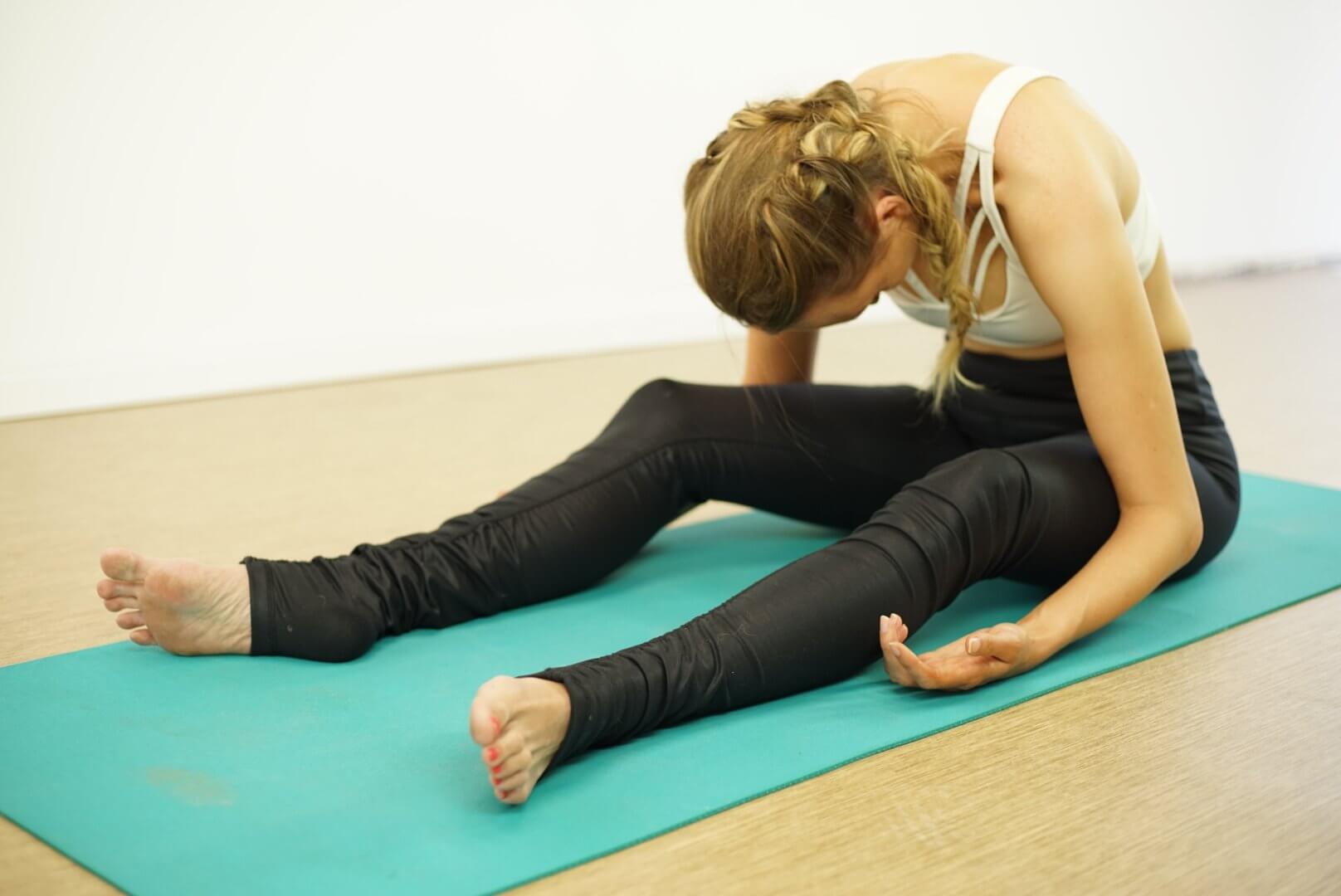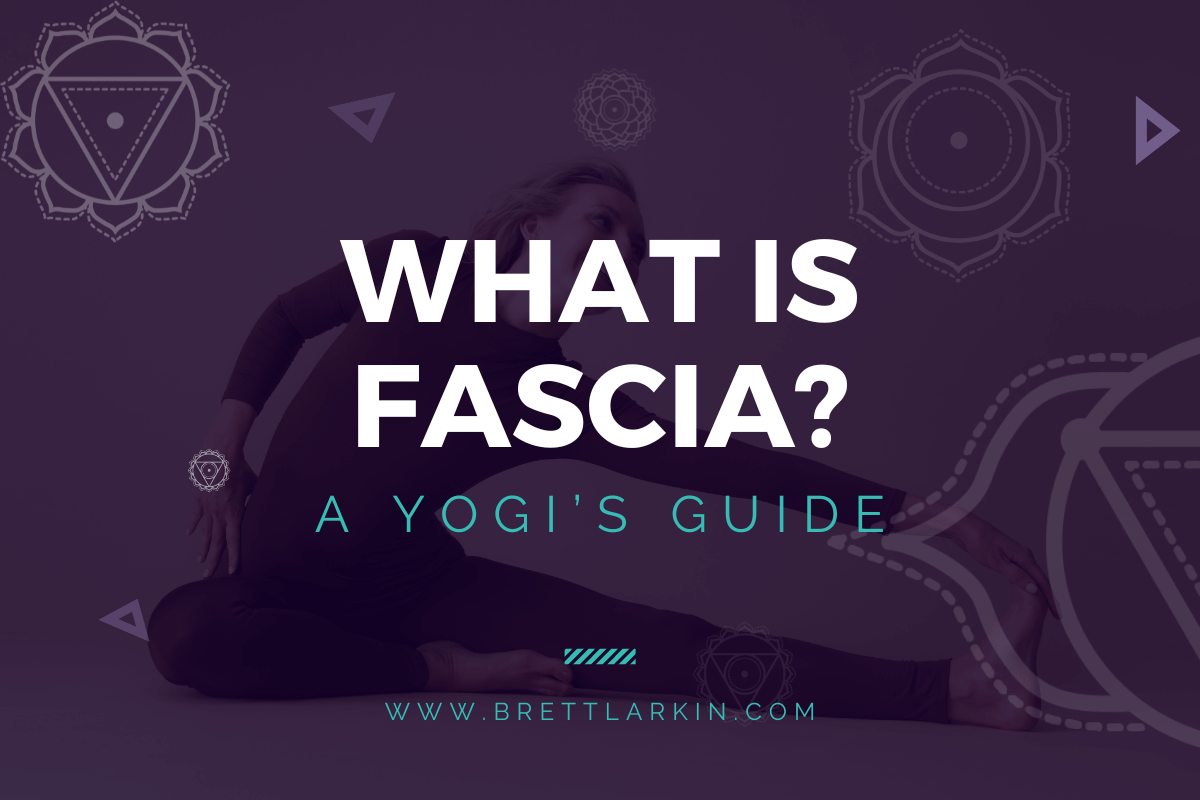Did you know there is spider web woven all through your body?
Okay, not really. But there is a connective tissue, fascial connective tissue to be exact, that is woven like a spider web all over your body. Sound weird? It’s actually really cool and one of my favorite topics!
What is fascia you ask? Well, yoga nerds, I am happy to tell you all about one of the most fascinating body systems.
What Is Fascia In The Body?

Fascia is a tough elasto-collagenous connective tissue that lies under your skin spreading through the body in a three dimensional web from head to foot. The fascial system is what helps your body hold its shape, connecting all parts: muscle fibers, bone tissue, your nervous system, blood vessels, organs, tendons and ligaments. Fascia wraps around everything, literally! 😲
But how?
Your fascia weaves through your system to create separation between the vessels, organs, bones, and muscles thus, keeping everything in its place within your body like a net. It creates space through where delicate nerves and blood vessels and fluids pass. Think of it like a matrix with a gelatin-like consistency that supports metabolic material through the body. This elasto-collagenous complex is made up of highly stretchable collagen fibers which also coil around elastic fibers.
I know, it sounds really complicated. Basically, think of your fascia like a giant 3-D spider web running through the entirety of your body, catching and holding things in their proper positions. On the cellular level it’s like a sieve, filtering everything through your system.
Research on this amazing connective tissue is still being done; but recent science can now define fascia even further by categorizing fascial tissues into multiple layers/types:
Superficial Fascia
Superficial fascia is the collagenous based soft tissues layered directly under the skin. It is the loosely packed interwoven collagen that makes up structures like the platysma muscle. Superficial fascia is a protective layer of connective tissue that separates muscles from your skin.
Deep Fascia
Deep fascia is the layer around your musculoskeletal system, in addition, this fascia surrounds your nerves and blood vessels. This deep fascia is then broken down into two sub categories:
- Aponeurotic fascia: This is the thicker, more fibrous fascial connective tissue that connects muscles spanning larger areas of the body. These would be muscles like those in the arms and legs. An example of this would be the fascia lata found in the thigh, or thoracolumbar fascia which surrounds the paraspinal muscles.
- Epimysial fascia: This sub-type of fascia covers and wraps around your skeletal muscles. This type of fascia surrounds major muscle groups and is more tightly connected to them as well, like your glutes or trapezius muscles.
Visceral Fascia
Visceral fascia are the connective tissues that surrounds your organs.
Parietal Fascia
Parietal fascia surrounds the lining of a body cavity. For example, this connective tissue lines areas such as the pelvis.
You can go even further defining fascial layers by their position in the body just as you would muscles. Plantar fascia for example, haven’t we all heard of painful plantar fasciitis? But not everyone subscribes to this methodology. Some practitioners believe the fascia to be a single organ that spans the body.
FUN FACT: Historically virtually nobody talked about fascia. Scientists used to throw it in the trash when studying cadavers 😱. But this is one of the most important pieces of your anatomical makeup. Which is why I have an entire module on it in my 200-Hour Online Yoga Teacher Training.
Experience 3 Training Videos from Inside My 200-Hour Online YTT 👇
Myofascial Pain And Fascial Adhesions

When trauma or inflammation happens in the body fascia tightens and the layers of fascia adhere to each other. This is a fascial adhesion.
Now, continue to think of your fascia like a giant 3-D spider web; If you were to put pressure on one part of the web, it ripples through the whole thing. You would see one side of the web press together and adhere to itself in order to maintain the integrity of the structure.
When you hold your body in continuous bracing patterns, or have continuous repetitive movement, like hunched over your phone or computer for example, your fascia is going to do the same thing. It will build up around the neck and shoulders to try and support your skeletal structure. This leads to fascial pain, restrictions, and adhesions.
What do fascia adhesions feel like?
Tight fascia and fascial adhesions (sometimes called trigger points) can often look like body stiffness or reduced mobility. As fascia tightens and creates a buildup around muscle cells and nerve fibers it can also lead to myofascial pain syndrome. Myofascial pain syndrome actually affects a large portion of the population and manifests in multiple ways:
- Spontaneous muscle pain
- Joint pain
- Referred pain
- Muscle weakness
- Loss of coordination
- Painful knots or trigger points
- Scar tissue
Modern science has also proven that fascial restrictions are often the cause of skeletal misalignments. This then leads to joint and muscle pain, headaches, chronic pain and health conditions like depression, compartment syndrome, TMJ, and fibromyalgia. This is why it is so important to keep your fascia healthy, so that you can avoid some of these symptoms or conditions.
The beauty of the fascia is that it WANTS to support you. It WANTS to protect you and the surrounding tissues of your body. This is why it creates restrictions in response to trauma(physical and/or emotional) or chronic bracing patterns. To protect you from hurting yourself further. That means you can also correct and release these adhesions. Your body wants to bring you to homeostasis and release tension that comes with fascia pain or myofascial pain syndrome 🎉.
That doesn’t mean it’ll change overnight. Healing isn’t always that easy, but you can use certain myofascial release techniques to rehydrate it, move it, strengthen it, and relieve fascia pain. And you can do them yourself in the privacy of your own home!
Fascia Release Techniques

A sad fact is that most forms of exercise neglect your fascia. Yes, that includes yoga. They don’t nourish or hydrate your interconnective tissue. But you can change that! You don’t need any previous knowledge of the fascia, or even any movement experience 🤯! As long as you have awareness, all you need is your body.
I’d love to go on this healing journey with you using my Fascial Fitness With Brett Larkin program. If you’re an Uplifted member you’ll find the series inside your membership! If that’s not in the cards for you right now, no worries! I’ll give you some myofascial release techniques for relieving pain and creating healthy fascia below.
How to break up fascia

The first thing you want to remember is that things don’t heal in a linear fashion and not instantaneously. Have patience with yourself and the process.
Before you start; some key principles when it comes to breaking up fascial trigger points or fascia adhesions are:
- Don’t judge
- Never force
- Soften instead of relax
- Take your time
- Don’t attach to an outcome
One tip is to try and get into a relaxed state as quickly as you can. Your fascia won’t release if you are tense. Have a visualization ready to help ground you or breathe into your solar plexus.
NOTE: Nothing should be super painful. It should be that good kind of sore pain you get from bodywork, nothing sharp, stabbing, or electric. If you cannot take a full complete breath in the position you are in you’ve gone to far and should back off. As always, please check with your health care provider before starting any new programs.
Start by exploring with your hands. Feel into the parts of your body where you hold the most tension. When you find a fascial restriction, it may feel like a nodule or a really tender/sore spot, you’ll want to apply equal pressure to the tension you feel in it. You want to harmonize with it and then wait for the fascia to melt under your hands. You can also do this by sitting on your foam roller for several moments once you find that tender spot before you start moving.
Foam rollers aren’t your only fascia ally. There are plenty of myofascial release tools you can use.
Other methods to break up fascia include:
- Traction – using a sustained pulling force on a limb or muscle to create tension. For example: fascial build up in the neck? Yin style forward fold will create traction along that back line to start to release it, spread it out, and rehydrate it.
- Undulations or Spirals – if you are on your ball or foam roller, when you feel a sticky or thick spot you may want to pause there and very gently undulate or spiral to assist in releasing that muscle tension.
- Rebounding – applying light pressure to areas, bouncing/shaking motion to create more chaos to help it release.
- Physical therapy modalities – whether this is heat therapy, massage therapy, or lymphatic system therapies. Working with a licensed therapist who eases muscle tension through body work is a great tool for keeping your fascia healthy.
ALSO NOTE: Myofascial release can be very traumatic and bring a lot of emotions so it’s a good idea to work with a licensed MFR therapist. John Barnes, my mentor, has a directory on his website.
How to strengthen fascia muscles
A regular practice is a great way to work with your fascia. But, fascia loves chaos so doing a 26+2 everyday isn’t going to do much for it. You’ve got to be more spontaneous with your movement. A great way to do this is with some somatic healing techniques.
Or, you can dance! Dancing is one of the best ways to take your body into new patterns of movement. This in turn strengthens the fascia. Give it a try with this class:
Plyometrics and jumping movements are great ways to strengthen your fascia as well. As my guest expert in 200-Hour Online Yoga Teacher Training Tom Myers will tell you; movements on your toes are great for strengthening your fascia. This could include:
- Box jumps
- Side jumps
- Jumping jacks
- Hopping/skipping
- Running on your toes
You can always look at the movements in my fascial fitness series and training plan to get more specific guided movements too. It will even show you how to mix up those movements, in order to strengthen your fascia.
How to rehydrate fascia muscles

Remember, your true nature IS fluid and organic. Just like your fascia! Your fascia should be able to move fluidly and slide as needed. When there is trauma it dehydrates and starts to harden or solidify like superglue. Or, if you aren’t properly hydrated, just like with any part of your body, your fascia will get stiff and brittle. This leads to mobility issues/restriction and stiff movements or fascia pain.
How can you keep this biological fabric hydrated and pliable?
When it comes to any type of hydration the first thing you need to do is make sure you are drinking enough water!! Although it can vary depending on your circumstances it is advised to drink anywhere between 2 – 4 liters of water a day. However, just drinking water is not enough. Movement will not only strengthen but it will also rehydrate your fascia. This is because movement organizes fascia(meaning the sedentary lifestyle of our modern world makes fascia disorganized 😟).
You can drink plenty of water but if you don’t release tight fascia and move, that water is not going to be able to travel through the fascia. You can rehydrate through regular exercise or foam rolling. A couple movement tips for rehydrating your fascia include:
Unprogrammed movement – also known as biomorphic movement. This could look like hip spirals, undulations, rainbow cat, or intuitive movement.
Move in between – take regular breaks to move your entire body. Every hour try to get up and do some squats or go for a short walk. Or if you’ve been working in the kitchen or cleaning the house for a while take a pause to do some calf raises or a juicy forward fold. You can even just bounce on your toes for thirty seconds!
If you integrate movements throughout your entire day you can combat a lot of the repetitive movements that occur in this modern digital world. This will keep your fascia nice and healthy 😉.
Check out this class to give self myofascial release a try:
Closing Thoughts
There are still a lot of differing opinions and controversy in the scientific community about fascial tissue. In my experience, working with the fascia can have a profound RIPPLE EFFECT on your body — and in your life. This is why I make a point to discuss it in depth within my training programs. I’m that passionate about it! I encourage you to get curious and start working with your fascia too. You won’t regret it!
Next Steps
- Take a deep dive into embodiment and somatic yoga with my Somatic Yoga certification program.
- If you’re interested in practical kriya yoga as a way to improve your daily life and relationships, check out my Yoga for Self Mastery course.
Experience 3 Training Videos from Inside My 200-Hour Online YTT

YOU MIGHT ALSO LIKE
- How to Teach Somatic Yoga to Beginners
- Best Somatic Yoga Poses for Emotional Release and Healing
- The Rich History of Somatic Yoga: From Origins to Modern Practices
- Somatic Yoga for Stress: Effective Techniques to Find Calm and Relief
- The Perfect Yoga Practice For Your Menstrual Cycle Energy Levels
- Enhancing Your Practice: The Benefits of Yoga and Nature Connection
- Gentle Somatic Yoga for Back Pain: Relief and Prevention Techniques
- How Somatic Yoga for Anxiety Can Help You Find Calm and Balance
- Somatic Stress Release Techniques for Emotional Balance
- Progressive Muscle Relaxation Meets Yoga for Deep Sleep
- 5 Somatic Hip Exercises For Beginners
- How To Relieve Myofascial Pain with Yoga: Heal and Prevent Muscle Tension
- Somatic Energy Healing: Techniques to Realign and Restore Balance
- How Somatic Shaking Can Release Tension and Reset Your Nervous System
- How To Create Mindful Somatic Yoga Sequences Your Students Will Love











